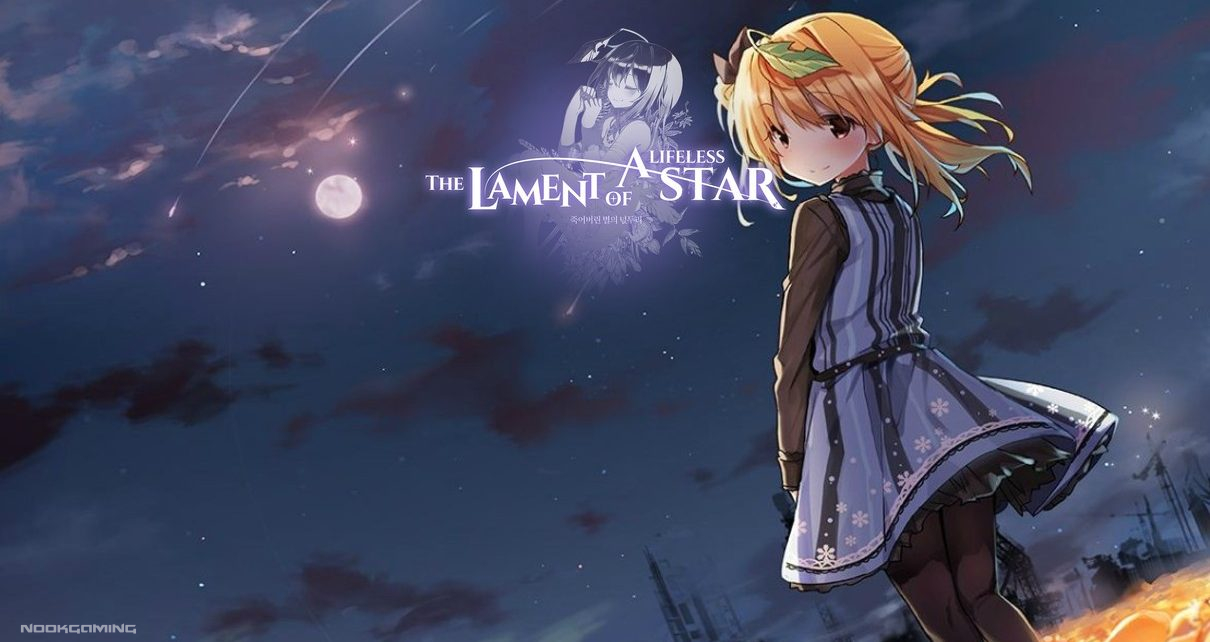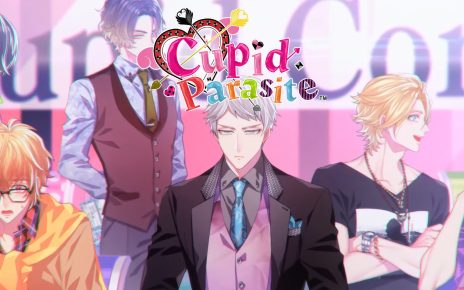The Lament of a Lifeless Star is my fourth visual novel from Korean studio Talesshop. I was interested in The Lament of a Lifeless Star because I’ve had good experiences with Talesshop’s work. In particular, the lead writer for this game, Workingdog, also wrote Her World, which I found impressive for how well it developed interesting, multi-faceted characters and deftly handled a slow-burn mystery. Unfortunately, Lament of a Lifeless Star didn’t live up to my expectations. It has interesting ideas and a strong conclusion, but the journey leaves a lot to be desired.

Looking for a Friend After the End
The Lament of a Lifeless Star tells the story of three survivors in a post-apocalyptic world. Humanity is gone and all that’s left are crumbling ruins, ashen wastelands, and decrepit machines. The story begins with Rami, a small girl imprisoned in a facility of cold metal, and Art, a mysterious wanderer who rescues her. The duo later meet Mirona, a robot maid with a strange habit of saying “kyu”. The trio roam the wastes in search of something–meaning, family, a reason to live–that the harsh world always seems to hold just out of reach. Can they build a life together after the end of the world?
In parallel with the story of Art, Rami, and Mirona, The Lament of a Lifeless Star paints a picture of life before the apocalypse through Art’s flashbacks. A prominent figure in these flashbacks is Yooshil, a mysterious blue-haired beauty who treats Art sweetly but emanates a subtle foreboding. It’s hinted that Yooshil is linked to Art’s strange abilities and to the end of the world itself. As you progress, these flashbacks begin to fill in some of the unanswered questions about how things came to be. However, The Lament of a Lifeless Star is content to leave much unsaid. This can be a double-edged sword. Sometimes, it works beautifully as a way to emphasize the importance of emotions and themes over infodumps, but at other times it can obscure characters’ motivations in an unsatisfying way.

Wasteland Wanderers
The biggest problem with The Lament of a Lifeless Star is that it doesn’t seem to know what it wants to be, bouncing wildly from serious science fiction drama to action scenes to tropey gags and banter to the kind of cutesiness you’d expect to see in a high school romcom moege. The opening scene is a perfect microcosm. We start off looking through Rami’s eyes as she contemplates her dismal fate, trapped, suffering, and forgotten, desperate for any sliver of hope that things might change. Then as soon as Art arrives, The Lament of a Lifeless Star launches right into tsundere gags and cheerful back and forths that highlight Rami’s cuteness. You even get cheap pervert jokes. It’s as if the characters instantly forgot the melancholy opening had ever happened. The whole scene is tonally incoherent, and this constant jumping between genres and moods with zero transition persists for most of the story.
The Lament of a Lifeless Star also feels aimless at times. While things are eventually made clear near the end, for most of the story you have very little context as to what the truths of the characters’ pasts or their overarching goals are. A good mystery can pull this off by focusing on smaller goals as the reveals slowly build up, but I don’t think The Lament of a Lifeless Star does this well either. Individual scenes might feature threats like zombies, hostile landscapes, or killer maid robots, but it feels like obstacles arise rather haphazardly and are dealt with likewise. Nor are the smaller obstacles the characters face woven into a larger thematic picture.

Madlads and Gags
I thought things got a bit better once the three leads had all been established and the gang set up camp. The character interactions move beyond surface tropes and explore deeper parts of the cast. Examining the characters’ hopes, fears, dreams, and insecurities fleshes them out and allows them to have more meaningful interactions where their relationships grow and develop. The romance-y stuff with Rami was a little weird since she’s so obviously a child, but Art and Mirona develop a good deal of chemistry and their banter is fun. Art himself can be trying though. He constantly acts like a trollish madlad whose first priority is to mess with everyone around him in the most ridiculous way possible, no matter the circumstances. Again, this can work… in a comedy visual novel. To his credit Art usually backs off if things go too far and is ultimately a good person when it counts, but his immature behavior grated on me. Maybe the writer wanted to make Art a bit of an antihero, but he just comes off as kind of a dick.
Although it putters away most of its runtime on tropes, gags, and banter, The Lament of a Lifeless Star does weave in some action. Sadly, this is not very well paced either. The secret to good action is anticipation. Think about your favorite battle shounen, and about how much time is devoted to build-up and foreshadowing compared to the actual throwdown at the end. Even the hypest action needs time to marinate for it to give a satisfying payoff. Like everything else in The Lament of a Lifeless Star, the action scenes feel haphazard. Stuff just kind of happens. Maybe it’s flashy exciting stuff with cool CGs and sound effects to go with, but it’s not interesting or satisfying beyond that surface level.

The Most Precious Thing
I will say that The Lament of a Lifeless Star has some interesting ideas. While it’s a post-apocalyptic story with a mystery at its center, it was also more forward looking than I expected. The world has already ended; there’s no going back and undoing things. Understanding the characters’ pasts is important for understanding their ideals and motivations, but the story’s main questions and themes focus on what it means to move forward in such a world. What debts does one owe to the world from before? What does it mean to find happiness when the apocalypse has come and gone? What is truly important in the desolate wastes left behind?
Because it focuses on these interesting themes and finally reveals enough for you to empathize with the characters’ experiences and motivations, the last third of The Lament of a Lifeless Star is significantly stronger than the rest. For the first time here I found myself sucked in, wanting to find out what happens next. The climax doesn’t hit as hard as it could because the buildup is all so uneven and the plot never stops being somewhat haphazard, but I still thought The Lament of a Lifeless Star managed to finish on a high note. There are 4 possible endings depending on your choices. I liked the true ending the best, but all of them are fitting endings, and they do a nice job emphasizing different characters for variety.

Art, Sound, and Extras
The presentation in The Lament of a Lifeless Star is impressively detailed and well thought out. The text switches between ADV and NVL to emphasize dialogue vs description or monologue, and the backgrounds and CGs vividly evoke the reality of life after the end of the world. The UI is a bit minimal in places–for example you can’t change the text speed–but it does include a convenient timeline feature that gives a quick overview of what you’ve read so far in case you want a refresher between play sessions and also allows you to replay any scene you’ve unlocked from the menu.
I thought the character art was nice too, though perhaps a bit cutesy for the story The Lament of a Lifeless Star wanted to tell. For example, the fact that humanity’s forces of war were robot maids felt like fanservice (or else maybe a prophecy that when the world ends it will be because otaku gain too much power). The voice actresses are quite expressive (Art is unvoiced), playing up Rami’s childishness, Yooshil’s sweetness, and Mirona’s mercurial nature. Again it could be a bit cutesy at times, but it also helped a lot in bringing those characters to life during the long stretches of little happening in the story.
The Lament of a Lifeless Star has a generous amount of extras, especially for a short visual novel. As you play, you’ll unlock TIPS, adding bits of lore, saved voice lines, CGs, and most substantially, extra scenes. These scenes are primarily comedy skits, but there are a good number and they have enough material to be worth a read if you enjoyed the characters and want to spend a little more time with them before you put The Lament of a Lifeless Star down.

Verdict
I think The Lament of a Lifeless Star has some interesting ideas about what it might mean to live past the end of the world. Unfortunately, the execution is uneven and most of The Lament of a Lifeless Star’s runtime is squandered on tropes and trivialities. The final act is better, but it’s too little too late to redeem the overall experience.
WAIT FOR SALE ON THE LAMENT OF A LIFELESS STAR
If you would like to see more Visual Novels, you may be interested in our review of Love Flute.
Many thanks go to TALESSHOP for a PC review code for The Lament of a Lifeless Star.
A veteran of Oregon Trail and Battletoads, Wes has been playing and talking about games for as long as he can remember. He’s down to try almost anything, and he especially enjoys games with gripping narrative experiences.





